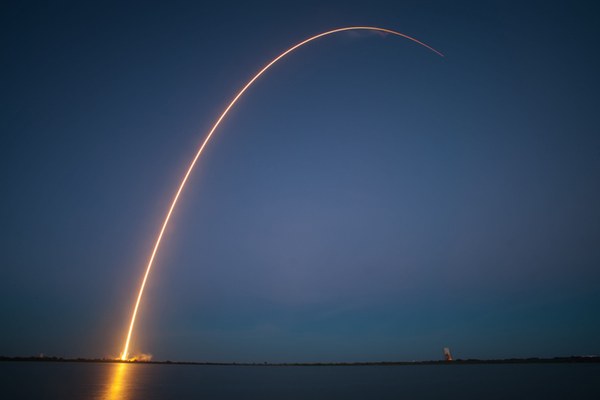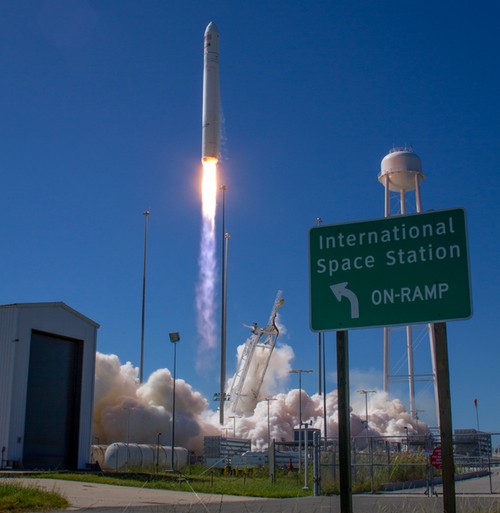
A long exposure time photo of the Falcon 9 v1.1 launch of the SES-8 satellite from Cape Canaveral on December 3, 2013. (credit: SpaceX)
[Editor’s Note: this is the first in a series of articles that will both review major events in commercial spaceflight in 2013 and preview what to expect to 2014.]
The year of 2013 will go down as one of the most significant years for the commercial launch industry in recent memory, thanks to the successful introduction of one new and one essentially-new launch vehicle, both by American companies. Those vehicles, which also have launches planned for early January, have the potential to alter the commercial launch industry by offering new, and in some cases lower-priced, options for customers in the US and elsewhere.
The first of these vehicles is Orbital Sciences Corporation’s Antares rocket. After lengthy delays due primarily to issues completing the rocket’s launch facilities at the Mid-Atlantic Regional Spaceport (MARS) in Virginia, the Antares launched on its inaugural flight on April 21, after a few days’ worth of scrubs because of technical and weather issues. That launch placed a mass simulator for the company’s Cygnus cargo spacecraft and several small satellites into low Earth orbit. Orbital followed up that launch nearly five months later with the first “operational” Antares launch on September 18, carrying a Cygnus cargo spacecraft on a test flight to the International Space Station. That mission fulfilled Orbital’s Commercial Orbital Transportation Services (COTS) agreement with NASA, an award that helped fund development of the Antares rocket and Cygnus cargo spacecraft. In both launches the Antares rocket, a two-stage rocket that uses “Americanized” versions of the Russian NK-33 engine in its first stage and a solid-propellant upper stage, performed as planned.
Two and a half weeks after the second Antares launch, SpaceX performed the first launch of its Falcon 9 v1.1 form Vandenberg Air Force Base in California. The company had billed the rocket as a modified version of the Falcon 9 that had performed five previous launches, most recently in March, but SpaceX president Gwynne Shotwell admitted later that “it’s really like the version 1001″, as it uses new Merlin 1D engines and a stretched first stage, among other upgrades. That inaugural launch successfully placed the CASSIOPE satellite for Canada and several smaller satellites into low Earth orbit, but the second stage failed to relight in a test after spacecraft separation. That relight wasn’t needed for the CASSIOPE mission, but would be needed on its next flight to place the SES-8 satellite into geosynchronous transfer orbit.
SpaceX said in November it tracked down the upper stage problem to frozen fuel lines for the igniter fuel for the second stage engine, due to those lines being next to cold liquid oxygen lines. Launch attempts on November 25 and 28 (Thanksgiving Day) were scrubbed because of technical issues, but the Falcon 9 did finally launch on the evening of December 3 from Cape Canaveral. Its second stage relit as needed, placing SES-8 in the proper “supersynchronous” transfer orbit.
Neither Orbital nor SpaceX will be resting on their laurels in 2014, with both companies planning launches in the first week of 2014. SpaceX is planning another Falcon 9 v1.1 launch on January 3, carrying the Thaicom 6 satellite to geosynchronous orbit on a mission very similar to SES-8. (Both SES-8 and Thiacom 6, as it turns out, are satellites built by Orbital.) SpaceX performed a static test fire of that Falcon 9 on the pad at Cape Canaveral on December 28, which, as of this writing, kept the launch on schedule for January 3.
Orbital, meanwhile, is planning another Antares launch no earlier than January 7. This will be the first of eight currently contracted Cygnus cargo missions to the ISS. That launch was planned for mid-December but postponed because of unplanned spacewalks on the ISS to repair a coolant loop on the station. The Cygnus’s payload, besides supplies for the ISS, also includes 28 small satellites for Planet Labs, the commercial remote sensing startup, that will be deployed from the ISS a few weeks after Cygnus berths with the station.

An Antares rocket, carrying a Cygnus cargo spacecraft, lifts off Sept. 18 from the Mid-Atlantic Regional Spaceport in Virginia, en route to the ISS. (credit: NASA/Bill Ingalls)
The successful introduction of both rockets, particularly the Falcon 9 v1.1, could have far-reaching effects on the launch industry in the US and worldwide. (Orbital’s Antares has had less of an impact so far, since its only launch contracts are for NASA ISS resupply missions, but the company has made clear its interest in seeking other commercial and government contracts.) SpaceX had already won a number of commercial launch contracts from operators of GEO communications satellites, which still constitute the largest part of the commercial launch market, and the success of SES-8 may help the company win additional contracts from those companies, many of whom are relatively risk-averse and tend to stay away from unproven launch vehicles.
The introduction of the Falcon 9 v1.1 comes at a time when the commercial launch industry is in a state of flux. The market had been dominated in recent years by three companies: Arianespace, International Launch Services (ILS), and, to a lesser extent, Sea Launch. But Sea Launch suffered a failure of its Zenit-3SL rocket in early 2013, destroying the Intelsat 27 satellite and grounding the rocket until April 2014. ILS, which markets the Proton rocket, continues to fight nagging concerns about the reliability of that rocket after a Proton failed in spectacular fashion on a Russian government mission in July. Others are trying to get into the market as well: Japan’s Mitsubishi Heavy Industries won a commercial launch contract from Canada’s Telesat, one of the “Big Four” commercial satellite operators, in September; that will be the first commercial GEO launch for the H-2A rocket. Even Lockheed Martin Commercial Launch Services, which markets the United Launch Alliance (ULA)-built Atlas V, won a rare commercial launch contract, also in September, for Mexico’s Morelos-3 satellite.
Arianespace remains on top of the commercial launch market, with a string of consecutive successful launches of its Ariane 5 stretching back more than a decade, but even its company executives recognize that they have to react to the shifts in the market. In particular, Arianespace, while offering a powerful and reliable launch vehicle, tends to be more expensive than other providers, especially SpaceX’s relatively low-cost Falcon 9. In a speech to the Washington Space Business Roundtable on December 3—just a few hours before the Falcon 9 SES-8 launch—Arianespace CEO Stéphane Israël acknowledged the changes in the market. “We know the competition is not getting any easier,” he said. The company, he said, is addressing this in several ways, including investments in a new, enlarged payload fairing for the Ariane 5 and even changes in pricing, particularly for smaller (2 to 3.4 ton) satellites. In an interview in November with the French newspaper Les Echos, Israël also hinted that Arianespace might lower its launch prices for some classes of satellites: “I have already said that I’m looking at our price policy, and that if we have to adapt because of competition, then we will do so.”
The success of both Antares and Falcon 9 v1.1 also brings them closer to another lucrative launch market: the US government. While both Orbital and SpaceX have NASA contracts to launch cargo missions to the ISS, Orbital has not won satellite launch contracts from NASA and the Defense Department, while SpaceX has only a couple: the Jason-3 satellite for NASA and two demonstration launches for the US Air Force, one using the as-yet-unflown Falcon Heavy. However, both are one launch away from flying three consecutive successful launches, which would be major milestones for certifying them for future military and civil government launches. (The Air Force has yet to confirm that the first Falcon 9 v1.1 launch in September counts as a success, Space News reported last week, because of the upper-stage relight issue.) If certified, SpaceX and Orbital could compete, starting most likely in 2015, for launches of national security payloads that today are effectively sole-sourced to ULA’s Atlas V and Delta IV.

No doubt 2013 was a big year and 2014 promises even more developments.
Beyond SpaceX and Orbital, Blue Origin may or may not share any of their activities and other players including those on the sub-orbital playground might start realizing some of the goals that seem so tantalizingly close.
Of course, there’s going to be some disappointment in there too- if any of this was easy, it’d already be done. Even the most successful program or project can be brought to its knees in the face of an extended root-cause investigation.
Let’s see what 2014 has in store!
…and thanks to Jeff and the Newspace Journal for making it easy to keep tabs on an interesting time and place for the industry!
-P